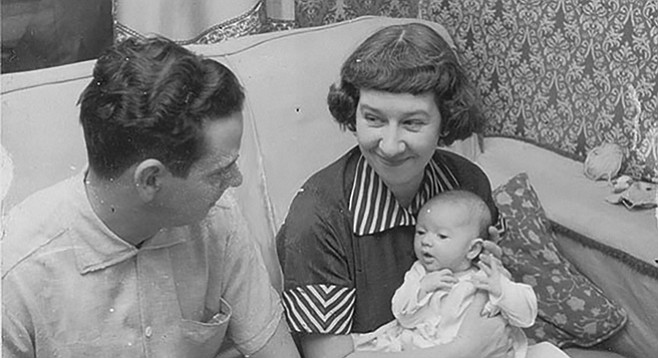Here's something you might be interested in.
Get Involved
 Facebook
Facebook
 X
X
 Instagram
Instagram
 TikTok
TikTok
 Youtube
Youtube

“I didn’t know there was so much humor,” said audience member Kim during the first intermission, an hour into Intrepid Theater Company’s Who’s Afraid of Virginia Woolf? She remembered the story from watching the 1966 Elizabeth Taylor movie, but she didn’t remember the laughs.
“Still, there’s so much bubbling beneath the surface,” Kim added, foreshadowing the crazy later acts, which are what have most likely subsumed her memories of the play’s undeniable humor.
Who’s Afraid of Virginia Woolf? isn’t “dated” per se, but the play’s roots (and talons) dig so deeply into mid-20th-century America, and its archetypical citizens, that I can’t shake the feeling of watching twisted versions of my grandparents exorcise (or perhaps simply “exercise”) their demons. My dad’s Greatest Generation parents rode the Eisenhower-era train straight to its final stop: for them, a cute ranch house in Newbury, Mass., and a comfortable retired life shaking up Jack Daniel’s Manhattans and cards with friends. That house, with its green shag carpet and lustrous use of knotty pine, will forever live etched in my memory as a mid-century American Dreamers home.
Despite the fact that most versions of Martha give her a more glamorous version of my grandmother’s haircut, and most stage renderings of “the living room” look a lot like my grandparents’ house, George and Martha have nothing in common with Ma and Grampy Pike.
Intrepid’s George (Robert Smyth), on the other hand, with his patrician New England accent, browline glasses, and magical combination of smug intellectualism and weary disappointment in the world and its workings; well, George could step right in whenever my late maternal grandfather Morse needed a break from telling younger people how shoddy and insincere things had become.
What this American theater classic leaves me wondering most is, do these archetypes even exist anymore? I’m inclined to think not. If anything, they exist as idealized versions of themselves, having been spared the critical eye of Albee’s generation, and reborn with the favorable glow of Madmen and craft cocktails. If Who’s Afraid of Virginia Woolf? could feel dated, it would do so because it fits the reality of a time and place that no longer makes sense.


“I didn’t know there was so much humor,” said audience member Kim during the first intermission, an hour into Intrepid Theater Company’s Who’s Afraid of Virginia Woolf? She remembered the story from watching the 1966 Elizabeth Taylor movie, but she didn’t remember the laughs.
“Still, there’s so much bubbling beneath the surface,” Kim added, foreshadowing the crazy later acts, which are what have most likely subsumed her memories of the play’s undeniable humor.
Who’s Afraid of Virginia Woolf? isn’t “dated” per se, but the play’s roots (and talons) dig so deeply into mid-20th-century America, and its archetypical citizens, that I can’t shake the feeling of watching twisted versions of my grandparents exorcise (or perhaps simply “exercise”) their demons. My dad’s Greatest Generation parents rode the Eisenhower-era train straight to its final stop: for them, a cute ranch house in Newbury, Mass., and a comfortable retired life shaking up Jack Daniel’s Manhattans and cards with friends. That house, with its green shag carpet and lustrous use of knotty pine, will forever live etched in my memory as a mid-century American Dreamers home.
Despite the fact that most versions of Martha give her a more glamorous version of my grandmother’s haircut, and most stage renderings of “the living room” look a lot like my grandparents’ house, George and Martha have nothing in common with Ma and Grampy Pike.
Intrepid’s George (Robert Smyth), on the other hand, with his patrician New England accent, browline glasses, and magical combination of smug intellectualism and weary disappointment in the world and its workings; well, George could step right in whenever my late maternal grandfather Morse needed a break from telling younger people how shoddy and insincere things had become.
What this American theater classic leaves me wondering most is, do these archetypes even exist anymore? I’m inclined to think not. If anything, they exist as idealized versions of themselves, having been spared the critical eye of Albee’s generation, and reborn with the favorable glow of Madmen and craft cocktails. If Who’s Afraid of Virginia Woolf? could feel dated, it would do so because it fits the reality of a time and place that no longer makes sense.
Comments